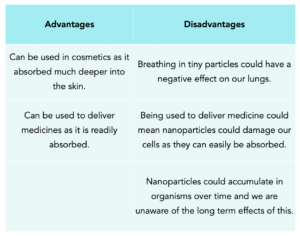Advantages & Risks of Nanoparticles (GCSE Chemistry)
Advantages & Risks of Nanoparticles
Advantages and Disadvantages of Nanoparticles
Scientists are researching more and more about nanoparticles and this is known as nanoscience to get a better understanding of the effects of nanoparticles.
There are many advantages of using nanoparticles in the various industries as discussed above. However, there are possible risks that should not be neglected. Below is a table outlining the advantages and disadvantages of using nanoparticles:

Nanoparticles are tiny particles that are smaller than 100 nanometers in size. They can be made from a variety of materials, including metals, polymers, and ceramics.
Nanoparticles have many potential advantages, including increased strength and durability, improved electrical conductivity, and enhanced catalytic activity. They can also be used in targeted drug delivery, as well as in the development of more efficient solar cells and batteries.
Yes, there are potential risks associated with nanoparticles. Because they are so small, they can easily enter the body and interact with cells and tissues in ways that larger particles cannot. Some studies suggest that certain types of nanoparticles could have toxic effects on the body, although more research is needed to fully understand these risks.
Nanoparticles can be used in targeted drug delivery, where they are designed to deliver medication directly to specific cells or tissues in the body. This can help reduce side effects and improve the efficacy of the medication. Nanoparticles can also be used in medical imaging, where they are used to highlight specific areas of the body for diagnostic purposes.
Nanoparticles have a wide range of industrial applications, including the development of new materials, such as stronger and lighter metals, as well as more efficient catalysts for chemical reactions. They can also be used in the production of electronic devices, such as computers and smartphones, and in the development of more efficient solar cells and batteries.
Some consumer products, such as sunscreens and cosmetics, contain nanoparticles. However, there are concerns about the potential risks associated with these products, as nanoparticles can easily penetrate the skin and enter the body. More research is needed to fully understand the long-term effects of these products on human health.
In many countries, nanoparticles are regulated by government agencies to ensure that they are safe for human use. For example, in the United States, the Food and Drug Administration (FDA) regulates the use of nanoparticles in food and medicine, while the Environmental Protection Agency (EPA) regulates their use in the environment. However, some experts believe that more stringent regulations are needed to fully protect public health.





Still got a question? Leave a comment
Leave a comment